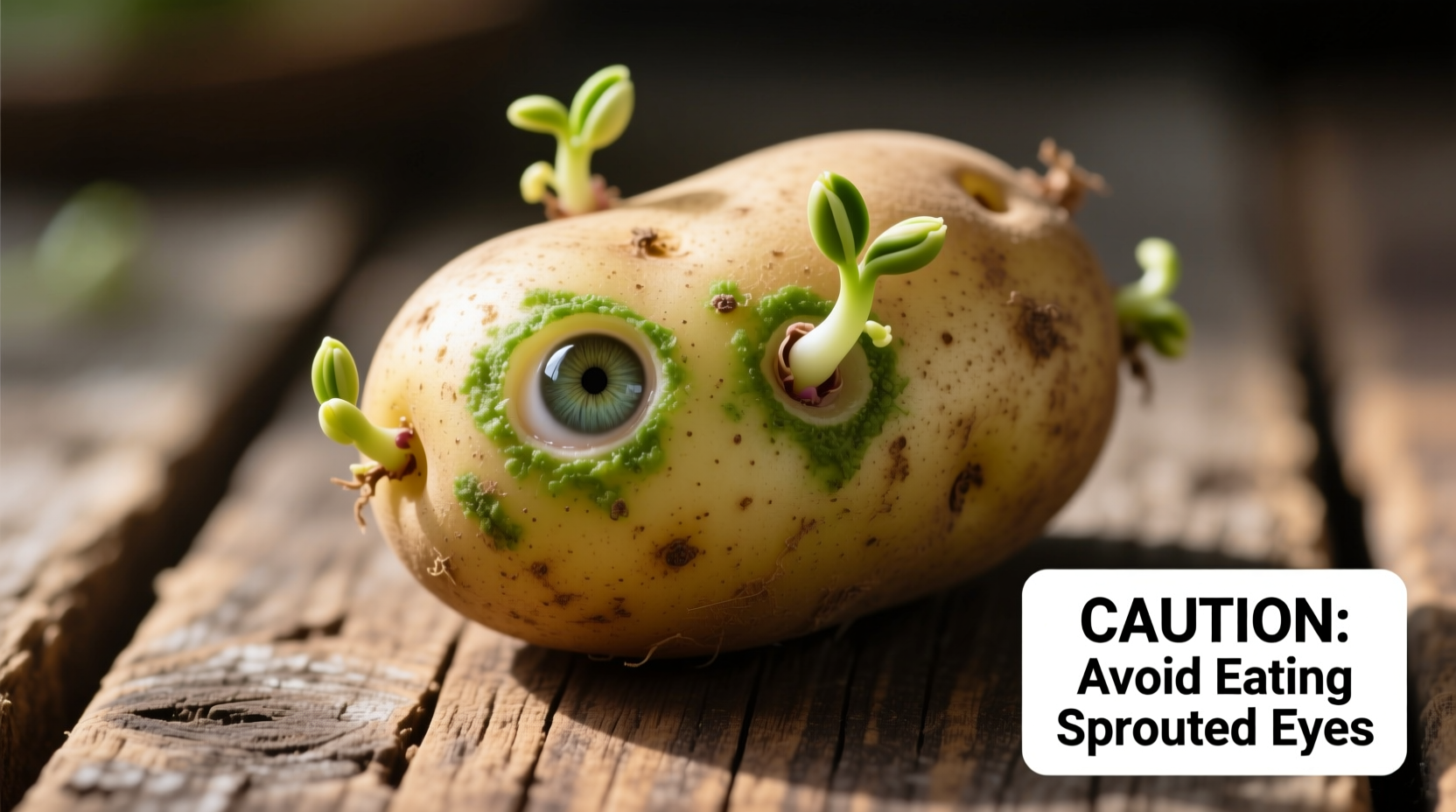Discover exactly when sprouted potatoes become unsafe and learn professional techniques to salvage slightly sprouted potatoes without risking your health. This guide provides science-backed safety thresholds and practical kitchen solutions used by culinary experts.
Understanding Potato Eyes and Sprouting
Potato eyes are the small indentations on a potato's surface where sprouts emerge when conditions trigger growth. This natural process occurs as potatoes attempt to reproduce. While sprouting itself isn't dangerous, it triggers biochemical changes that increase concentrations of solanine and chaconine—natural defense compounds produced by nightshade plants.
According to the U.S. Food and Drug Administration, these glycoalkaloids concentrate primarily in:
- The sprouts and eyes (highest concentration)
- Green-tinged skin areas
- The layer just beneath the skin

When Potato Eyes Become Dangerous: The Solanine Threshold
The critical safety threshold occurs when solanine levels exceed 20-25 mg per 100 grams of potato. At this concentration, consumption can cause adverse effects. The Centers for Disease Control and Prevention documents multiple cases of solanine poisoning from improperly stored potatoes.
| Potato Condition | Solanine Level (mg/100g) | Safety Recommendation |
|---|---|---|
| Fresh, firm potato | 2-10 | Perfectly safe to eat |
| Minor sprouting (small eyes) | 15-25 | Safe after proper preparation |
| Extensive sprouting + green skin | 200-1000 | Discard immediately |
| Rotted or mushy potatoes | Variable (often high) | Discard immediately |
Practical Safety Guidelines for Home Cooks
Follow these evidence-based steps to safely handle potatoes with minor sprouting:
Step 1: Assess the Sprouting Level
Examine your potatoes for these critical indicators:
- Minor sprouting: Small eyes (¼ inch or less) with no green skin
- Unsafe condition: Sprouts longer than ½ inch, green discoloration, or soft spots
Step 2: Proper Removal Technique
If sprouts are minor and skin remains yellow/tan:
- Cut deeply around each eye (at least ¼ inch below surface)
- Remove all visible sprouts completely
- Peel generously to remove the solanine-concentrated layer beneath skin
- Discard any green-tinged portions immediately
Step 3: Cooking Considerations
Boiling reduces solanine levels by approximately 40%, while frying can concentrate toxins in the oil. The National Institutes of Health confirms that no cooking method eliminates solanine completely—proper preparation before cooking is essential.
Potato Sprouting Timeline and Risk Development
Understanding how solanine levels change over time helps determine safety:
- Days 1-7: Dormant period (optimal storage conditions)
- Weeks 2-3: Eyes begin to swell (solanine begins increasing)
- Week 4: Visible sprouts emerge (solanine concentration doubles)
- Week 5-6: Sprouts lengthen, skin may turn green (solanine reaches dangerous levels)
- Week 7+: Significant sprouting with potential rot (highly toxic)
Preventing Potato Sprouting: Storage Best Practices
Extend your potatoes' shelf life with these professional storage techniques:
- Store in cool (45-50°F), dark, well-ventilated space
- Never refrigerate—cold temperatures increase sugar conversion
- Keep away from onions (they release gases that accelerate sprouting)
- Use paper bags instead of plastic for better air circulation
- Check weekly and remove any starting to sprout
According to USDA storage guidelines, properly stored potatoes maintain quality for 2-3 months. The University of Idaho's Potato School confirms that storing potatoes with an apple can delay sprouting, as apples release ethylene gas that inhibits growth.
When to Definitely Discard Potatoes
Throw out potatoes immediately if you notice:
- Extensive sprouting (sprouts longer than 1 inch)
- Green discoloration covering more than 25% of the surface
- Soft, mushy texture or foul odor
- Visible mold growth
When in doubt, throw it out. The FDA's food safety guidelines emphasize that no amount of preparation can make severely sprouted potatoes safe for consumption.
Recognizing Solanine Poisoning Symptoms
While rare from home-cooked potatoes, solanine toxicity can cause:
- Nausea and vomiting (within 8-12 hours)
- Headache and dizziness
- Abdominal pain and diarrhea
- In severe cases: fever, confusion, or difficulty breathing
If you experience these symptoms after eating potatoes with eyes or green skin, contact poison control or seek medical attention immediately.
Professional Kitchen Practices for Potato Safety
Chefs follow these additional protocols when handling potatoes:
- Conduct daily visual inspections of all root vegetables
- Use the "thumb test"—if you can easily press a thumb into the potato, it's too soft
- Store potatoes in breathable containers with humidity control
- Implement first-in, first-out inventory rotation
- Train staff to recognize early sprouting signs
These practices, documented by the National Restaurant Association's food safety guidelines, prevent solanine-related issues in professional settings.
Common Misconceptions About Potato Eyes
Let's address some persistent myths:
- Myth: Cooking destroys all solanine
Fact: Solanine is heat-stable and only partially reduced by cooking - Myth: Only green potatoes are dangerous
Fact: Solanine can be present without visible green coloring - Myth: Peeling alone makes sprouted potatoes safe
Fact: Deep cutting around eyes is necessary to remove concentrated toxin areas
Final Safety Recommendations
For complete peace of mind when preparing potatoes:
- Inspect potatoes before purchase—avoid any with visible eyes or green spots
- Store properly to delay sprouting as long as possible
- When minor sprouting occurs, cut deeply around eyes and discard green portions
- Never eat potatoes with extensive sprouting or significant green discoloration
- Teach children to recognize unsafe potatoes











 浙公网安备
33010002000092号
浙公网安备
33010002000092号 浙B2-20120091-4
浙B2-20120091-4